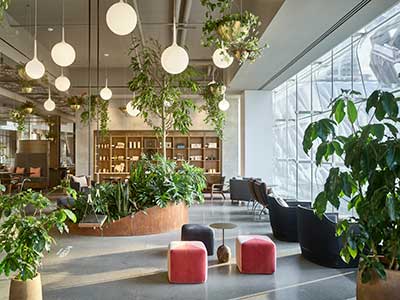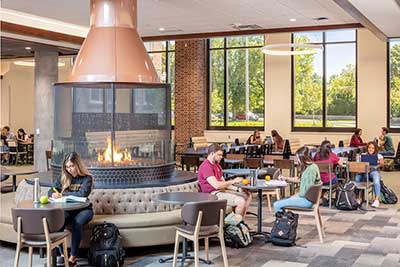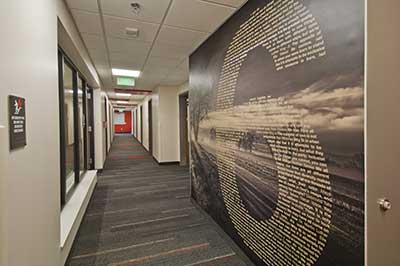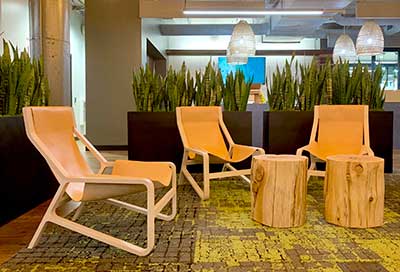Improving Students’ Mental Health with Biophilic Design
12/19/2023
Students in colleges and universities spend a majority of their time indoors. By incorporating biophilic design – the practice of reconnecting people and nature within the built environment – can help improve students’ physical and mental well-being, says Paul Wuennenberg, KWK Architects Principal and higher education design expert.
Biophilic elements can be incorporated in higher education designs in a number of ways; many of which involve the use of greenery, fire, natural light and textures to appease the occupants’ senses and promote such mental and physical benefits as decreased anxiety, lower blood pressure, fewer illness symptoms, increased social interaction, improved coping skills and enhanced attention span, among others.
Incorporating vegetation in a design can be one of the easiest ways to bring the natural environment indoors. An alternative to using live plants, preserved moss walls are a less costly option to integrate biophilic elements that require little to no maintenance compared to living walls. Living plant and moss walls are more visible and accessible than ever becoming staples in higher education design.
While fire does have limited uses indoors, incorporating fireplaces in dining and lounging areas where students often gather can add an appeasing element of warmth, color and movement to the space and make students feel cozy and secure.
Incorporating natural light in a design can also have a huge impact on a student’s overall mood and well-being. Large windows with sweeping views of outdoor foliage and the use of skylights, glass and atriums create natural shadows and light movement throughout the day to stimulate students’ senses while allowing them to observe changing weather patterns directly.
In spaces where artificial lighting is necessary, incorporating circadian lighting that supports a person’s circadian rhythm and psychological health is a good option. Circadian lighting supports biophilic design as it mimics light cycles that occur in nature and helps to reset students’ internal clocks.
Easy being green

Some of the more popular forms of “plantscaping” include the use of hanging baskets and decorative planters filled with greenery.
Sit by the fire

The Pioneer residence hall at the University of Minnesota features multiple fireplaces, including a cylindrical, glass-surround fireplace with seating in the dining hall. The windows also provide sweeping views of outside greenery.
Local nature

Wayfinding at Williams Village East residence hall at the University of Colorado-Boulder uses graphics that feature photography of local Boulder nature destinations which are also mapped out on a full-scale wall map in the hall’s first-floor game room.
Natural materials

Indirectly, students may also experience the benefits of nature within their environments through the use of nature images and colors such as earth tones, blues and greens, materials such as cork, wood and bamboo.